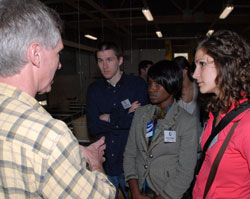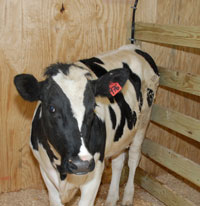 Three SUPERVALU employees have used their ice cream creative talent to take home the prize in the the company’s employee “Stone Ridge Creamery Name Your Dream Flavor Sweepstakes.” In addition to receiving free ice cream for a year and a $500 gift card, the winning associates will have their dream flavors added to the Stone Ridge Creamery lineup and their caricatures featured on the carton.
Three SUPERVALU employees have used their ice cream creative talent to take home the prize in the the company’s employee “Stone Ridge Creamery Name Your Dream Flavor Sweepstakes.” In addition to receiving free ice cream for a year and a $500 gift card, the winning associates will have their dream flavors added to the Stone Ridge Creamery lineup and their caricatures featured on the carton.
The winning associates and their “dream flavors” are:
* Tom Lindberg, retail technology specialist for SUPERVALU’s supply chain services northern region in Minneapolis, for his “Twisted Pretzel” flavor;
* Amy Youngblood, senior business support specialist at SUPERVALU’s innovation center in Minneapolis, for her “Red Velvet Cake” flavor; and
* Joe Agrusa, direct store delivery receiver at the Albertsons store in Chula Vista, Calif., for his “Italian Kiss” flavor.
All three flavors are now available nationwide at SUPERVALU’s family of grocery stores, including Acme(R), Cub Foods(R), Farm Fresh(R), Hornbacher’s(R), Jewel-Osco(R), Shaw’s/Star Market(TM), Shop ‘n Save(R) and Shoppers Food & Pharmacy(R), as well as at select independent grocery retailers who are affiliated with SUPERVALU.
Last year, SUPERVALU invited associates from across the company to show their love for the company’s private-label Stone Ridge Creamery brand of ice creams, sherbets and tart frozen yogurts by entering their “dream” ice cream flavors in the sweepstakes. The company received nearly 1,500 submissions, of which Lindberg’s, Youngblood’s and Agrusa’s were selected winners.
Lindberg has always been an ice cream lover, so learning that his “Twisted Pretzel” flavor was going to be churned into reality was a true thrill. Lindberg’s “Twisted Pretzel” features sea salt-infused caramel and crunchy dark chocolate-coated pretzel pieces in a bed of rich vanilla ice cream.
“As a kid, I ate ice cream almost every day and put everything imaginable in it, from a variety of syrups and fruits to things like nuts, pretzels and even popcorn. I really like the combination of sweet and salty, as well as having something crunchy,” Lindberg said. “Hands down, however, my favorite thing to put on ice cream is caramel. When the contest came up, I discussed it with my family, and we decided that caramel was mandatory, and pretzels would be good, especially if covered in chocolate. All of my friends and family are so excited and can’t wait to see it on the shelves.”
For Youngblood, the idea of a Red Velvet Cake-flavored ice cream conjured up many happy memories with her family. Her “Red Velvet Cake” ice cream, which will be a first for any major ice cream brand, is deep red in color infused with rich flavors of chocolate and decadent cream cheese frosting.
“Red Velvet Cake has long been a favorite family dessert for any celebration — from birthdays to weddings,” Youngblood said. “I also thought this flavor would be a great choice because Red Velvet Cake itself is a classic, nostalgic flavor that would be a natural addition to the retro feel of the Stone Ridge Creamery lineup. However, it still feels modern and innovative since it’s a flavor not commonly found in ice cream.”
Agrusa came up with “Italian Kiss” after being inspired by memories of growing up in Italy. The new flavor is a blend of chocolate ice cream, hazelnut and dark chocolate chunks, reminiscent of an Italian treat Agrusa enjoyed as a child.
“This is a very intense and complex flavor that I think will have broad mass-market appeal,” Agrusa said. “I am excited about being a winner, and I hope this flavor takes off and generates lots of sales.”
Source: SUPERVALU INC.
 Attention dairy farmers – applications for the third annual National Beef Quality Assurance (BQA) Award are now being accepted.
Attention dairy farmers – applications for the third annual National Beef Quality Assurance (BQA) Award are now being accepted.


 One of the important lessons the students learned during the 2nd annual “Science: A Foundation for Dynamic Careers” days at
One of the important lessons the students learned during the 2nd annual “Science: A Foundation for Dynamic Careers” days at  “That’s a crucial point that I don’t think a lot of young people understand … including myself. The more I got engaged today, the more I learned how important of a problem we’re going to be facing as a world, not just a nation. For the science [Novus] engages in to help produce more food, I think, is commendable.”
“That’s a crucial point that I don’t think a lot of young people understand … including myself. The more I got engaged today, the more I learned how important of a problem we’re going to be facing as a world, not just a nation. For the science [Novus] engages in to help produce more food, I think, is commendable.”

